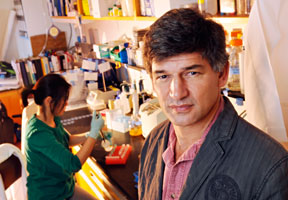Andries Steyn, Ph.D., grew up close to Cape Town, South Africa — a part of the world where tuberculosis (TB) is raging due primarily to the high number of people with HIV.
 |
| According to Andries Steyn, one-third of the world is latently infected with TB — more than 2 billion people. |
Steyn learned about the disease during his postdoctoral work at the Albert Einstein College of Medicine in New York when he met Barry Bloom, a leading scientist in the areas of infectious diseases, vaccines and global health.
“When I told him I was from South Africa, he asked me all about the TB problems in the country, and I didn’t really know anything about TB at that point,” Steyn says. “I didn’t even know South Africa had the highest TB incidence in the world. I was from the country and didn’t even know that.”
Steyn was intrigued. He was finishing his work in the lab of Julius Marmur, a biochemist and geneticist who discovered that denaturation of DNA was reversible, and joined Bloom’s lab afterward. Bloom is considered a world-renowned TB investigator, and when he left Albert Einstein to become dean at Harvard, Steyn followed and spent the next five years learning the intricacies of this complicated disease.
“We’re dealing with a real hard-core bug,” says Steyn, an associate professor of microbiology whose lab is deep into groundbreaking research of TB. “One-third of the world is latently infected with TB. That’s more than 2 billion people latently affected — and there are no drugs to kill dormant TB, and there’s no good vaccine against it.”
A new drug to combat TB has not been discovered since the 1950s, and Steyn says that drug — isoniazid — was discovered by accident.
Today, TB researchers around the world are centered on trying to understand which genes enable TB to enter, maintain and emerge from its dormant state within the lungs. There are drugs available to treat the clinical strains of TB, but developing countries are experiencing higher incidences of more extreme drug-resistant forms of the disease; current drugs don’t always offer successful treatment results. Researchers believe new drugs can be developed to combat TB if they can find the keys to unlock the mystery of its dormant state.
Steyn’s lab has looked extensively into the role of oxygen and nitric oxide in TB dormancy.
TB settles into the lungs when it is inhaled, and the body’s immune system activates and attempts to wall off the disease. TB responds by forming a granuloma-type structure that houses it in a low-oxygen environment, which researchers believe sends the signal for TB to enter a dormant state.
Some evidence also shows TB reacts the same way to nitric oxide, a chemical produced naturally by the body that is supposed to kill TB.
Steyn’s lab has dissected the way TB senses oxygen and discovered two very specific TB sensing molecules that binds to the oxygen and nitric oxide molecules through heme — the deep red iron-containing prosthetic group of hemoglobin and myoglobin.
“What nitric oxide and oxygen does to TB — even though they are two totally different molecules — they induce the exact same genetic response,” Steyn says. “That is pretty unique.”
Steyn’s lab also has discovered a third dormancy signal, carbon monoxide. Carbon monoxide, like nitric oxide, is produced in the lungs, and small quantities of those gases are released in the body.
Steyn says these discoveries have changed scientific thinking. “The body is trying to protect itself by producing these protective molecules,” Steyn says, “but those molecules are being sensed by TB, which then presumably enables TB to become dormant.”
The discovery of carbon monoxide’s role in TB dormancy could have a number of implications, especially considering cigarette smoke contains large quantities of carbon monoxide, and is the third biggest risk factor for TB.
“We have discovered carbon monoxide’s role independently and to the best of our knowledge we are the only lab in the TB field studying the genetic mechanism for how cigarette smoke exacerbates TB,” Steyn says. “Our basic research is being translated from bench to bedside and has public health and socioeconomic implications.”
Steyn says his research does not claim nitric oxide and carbon monoxide induce a dormant state, but that they are implicated in dormancy. How that happens has yet to be discovered.
“If we can understand the mechanism and know how it works, that would enable us to develop drugs that target dormancy,” Steyn says. “I’m a proponent of finding a drug to kill TB in its dormant state, but since human lungs most likely contain dormant and active growing TB, developing a combination drug or cocktail to target dormant TB and active growing TB would be an option.”
“Every 10 to 15 seconds someone dies from TB, which is a pretty devastating statistic,” Steyn continues. “If we can make a contribution to understanding the disease or its pathology, then that will be fantastic. And we have the potential to develop diagnostic tools or drugs that can directly affect the suffering of millions of people. Whether it’s a vaccine or a drug doesn’t really matter. It’s just an opportunity to change people’s lives in a very direct way.”